Robotics isn’t a concept confined to the future anymore; it’s actively transforming industries and revolutionizing our daily lives. From AI innovations led by Elon Musk to robots reshaping agriculture and healthcare, 2025 promises groundbreaking developments in the world of robotics. In this blog, we’ll dive into the definition, its applications, and the top trends that are setting the stage for the future of robotics industry. We’ll also explore questions like, ‘What is robotics in artificial intelligence?’ and ‘What’s next for next-generation robotics?’ Let’s dive in!
What is Robotics?
Robotics is a multidisciplinary field combining mechanical engineering, electrical engineering, computer science, and artificial intelligence (AI) to design and build robots capable of performing human-like actions or tasks autonomously. These robots are used across various industries to improve efficiency, safety, and precision.
| Keyword | Definition |
| Robot | A machine designed to execute tasks, often programmable by a computer. |
| Automation | The use of machines and technology to perform tasks without human intervention. |
The rise of generative AI is also trending now a days.
What Are the 5 Major Fields of Robotics?
The future of robotics lies in its major fields that encompass essential aspects dealing functionality and adaptability of robots:
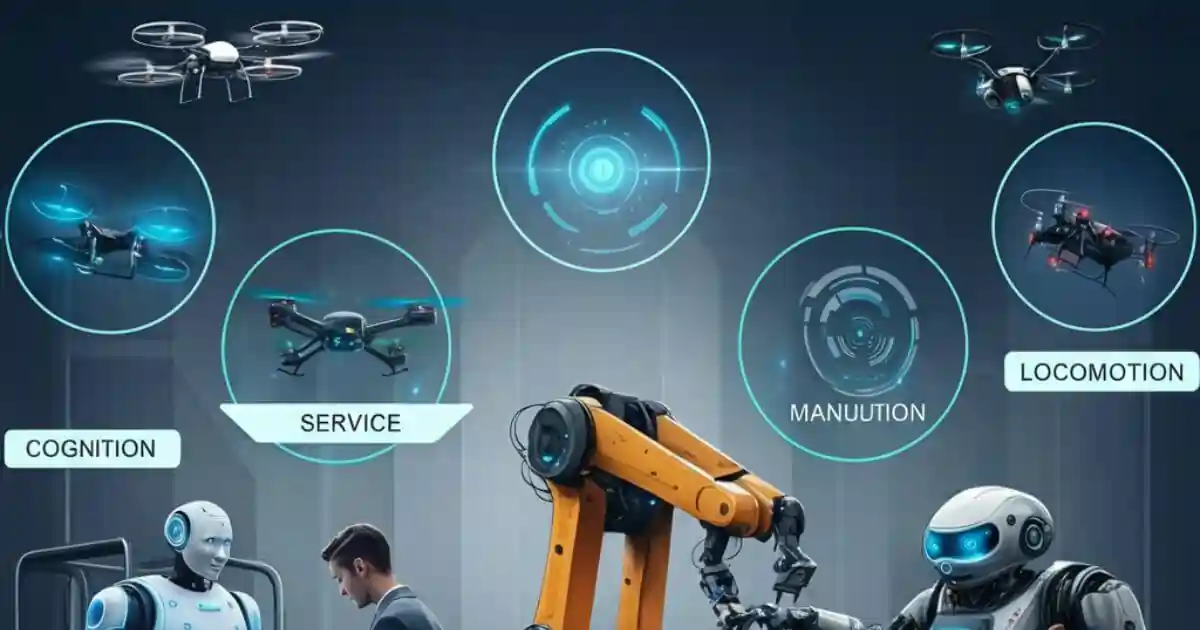
- Perception
At its core, perception is all about how robots see and sense the world around them and the first important feature in terms of future of robotics. Using sensors, cameras, and advanced software, robots gather data about their surroundings. Much like human eyes and ears, these tools allow the robot to interpret its environment.
Key Features of Perception
- Sensors and Cameras – Robots are equipped with tools to detect light, temperature, sound, and movement.
- AI Algorithms – These process raw sensory input into valuable insights, enabling the robot to understand spatial relationships and context.
Examples of Perception in Action
- Autonomous Vehicles – Self-driving cars like those developed by Tesla use vision systems to detect pedestrians, traffic signals, and other vehicles.
- Drones – Equipped with cameras and LiDAR, drones can map terrains, monitor crops, or even inspect infrastructure.
To talk about promising future of robotics, perception is the foundation that allows robots to make sense of complex, real-world environments.
- Cognition
Cognition focuses on the brainpower of robots, enabling them to make decisions and solve problems autonomously. Future of robotics lies in the fact that these are equipped with cognition can assess situations, predict outcomes, and take optimal actions based on insights derived from data.
Key Features of Cognition
- AI Integration – Leveraging neural networks and machine learning models for decision-making.
- Task Execution – Robots are programmed to prioritize, plan, and perform actions without human intervention.
Examples of Cognition in Action
- Customer Service Robots – AI-powered robots in retail stores are now capable of providing shopping assistance, answering questions, and processing returns.
- Healthcare Robots – Robots in hospitals can assess patient data to predict urgent care needs.
Cognition ensures the future of robotics as it makes AI and robotics more adaptable to dynamic environments, allowing them to collaborate as intelligent assistants rather than passive tools.
- Manipulation
The future of robotics lies in that it focuses on the physical interaction of robots with the world. Robots designed for manipulation excel at performing tasks that require precision and dexterity, such as assembling microchips or conducting minimally invasive surgeries.
Key Features of Manipulation
- Robotic Arms – Equipped with fine motor skills to handle objects of varying sizes and shapes.
- Grip and Tools – Advanced grippers, suction cups, and other tools enable robots to perform delicate or intricate operations.
Examples of Manipulation in Action
- Manufacturing – Assembly line robots in factories assemble cars, package goods, or build circuit boards quickly and accurately.
- Surgery – Robotic instruments like the da Vinci Surgical System allow surgeons to perform intricate procedures through tiny incisions.
Manipulation is transforming numerous industries, streamlining production, and enhancing surgical precision.
- Locomotion
The future of robotics is all about to explores the way robots move. Whether it’s traversing rugged terrain, navigating city streets, or exploring distant planets, locomotion is key to deploying robots that seamlessly adapt to their operational environments.
Key Features of Locomotion
- Mobility Mechanisms – These include wheels, legs, or tracks tailored for different surfaces.
- Advanced Movement Algorithms – AI ensures controlled, efficient, and adaptive motion.
Examples of Locomotion in Action
- Spot by Boston Dynamics – This quadruped robot is designed to handle rough terrains, making it ideal for industrial inspections or disaster response.
- NASA’s Rovers – Mars rovers like Perseverance explore landscapes millions of miles away, collecting samples and conducting experiments.
Locomotion expands the operational reach of robots, empowering them to perform tasks in environments humans either cannot or should not access.
- Interaction
Interaction bridges the gap between robots and humans (or other machines). It’s all about how robots communicate, understand, and respond in ways that foster collaboration and trust.
Key Features of Interaction
- Speech and Gesture Recognition – Enables robots to understand voice commands and interpret body language.
- Collaboration Tools – Robots are programmed to work alongside humans or other robots seamlessly.
Examples of Interaction in Action
- Pepper the Robot – Designed to engage in customer-facing roles, Pepper can answer questions, provide directions, and even read emotions.
- Cobots – Collaborative robots (cobots) are designed to work safely alongside humans in industries like manufacturing.
Interaction makes robots not just tools but a valuable part of the team, bringing humanity closer to smarter workspaces and life-enhancing solutions. And it is where the future of robotics lies.

Interactive Quiz:
- Question: Which field of robotics focuses on decision-making capabilities?
- A) Perception
- B) Cognition
- C) Manipulation
Fun Fact:
Did you know? The term “robot” originates from the Czech word robota, meaning forced labor.
Applications of Robotics in the Context of Automation
Robotics is transforming industries, improving efficiency, and solving complex challenges. Here’s how revolutionizing of various sectors, entitled to the future of robotics:
- Healthcare
First sector entitled to the future of robotics is their use in healthcare.
- Surgical Robots: Perform minimally invasive surgeries with high precision (e.g., da Vinci Surgical System).
- Robotic Prosthetics: Aid in rehabilitation by restoring mobility and function.
- Assistance Robots: Help with patient monitoring, medication distribution, and mobility assistance.
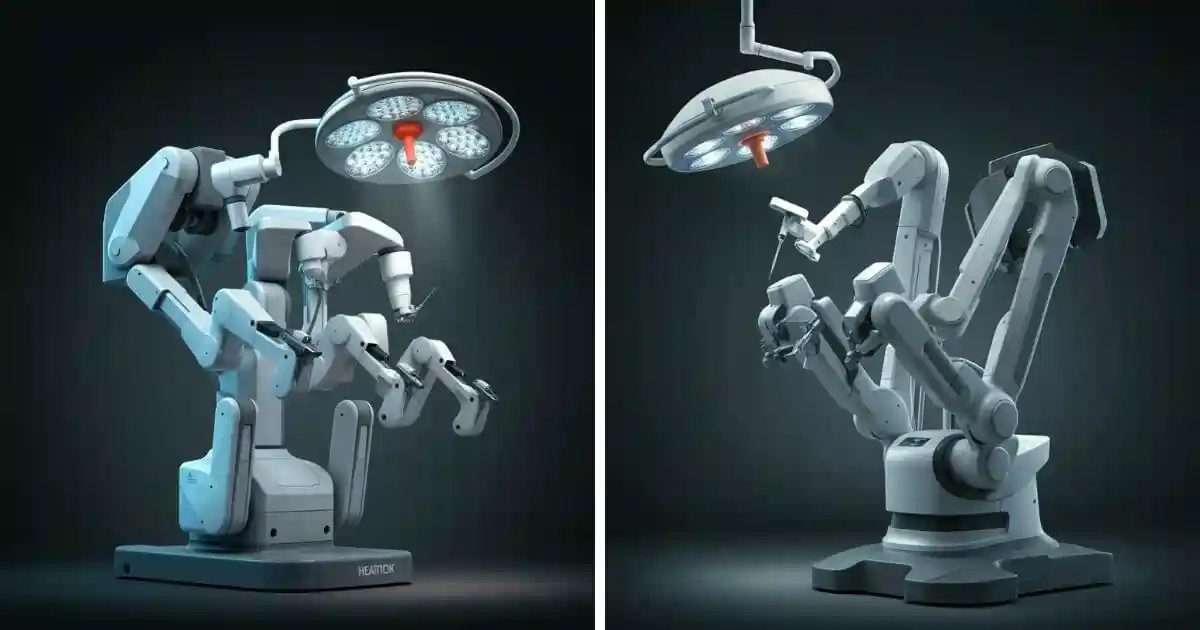
- Agriculture
The second sector entitled to the future of robotics is their use in agriculture.
- Precision Farming: Robots monitor soil conditions, detect diseases, and assist in planting and harvesting.
- Autonomous Tractors: Reduce labor costs and improve farming efficiency.
- Robotic Drones: Monitor crops for pests and environmental changes.
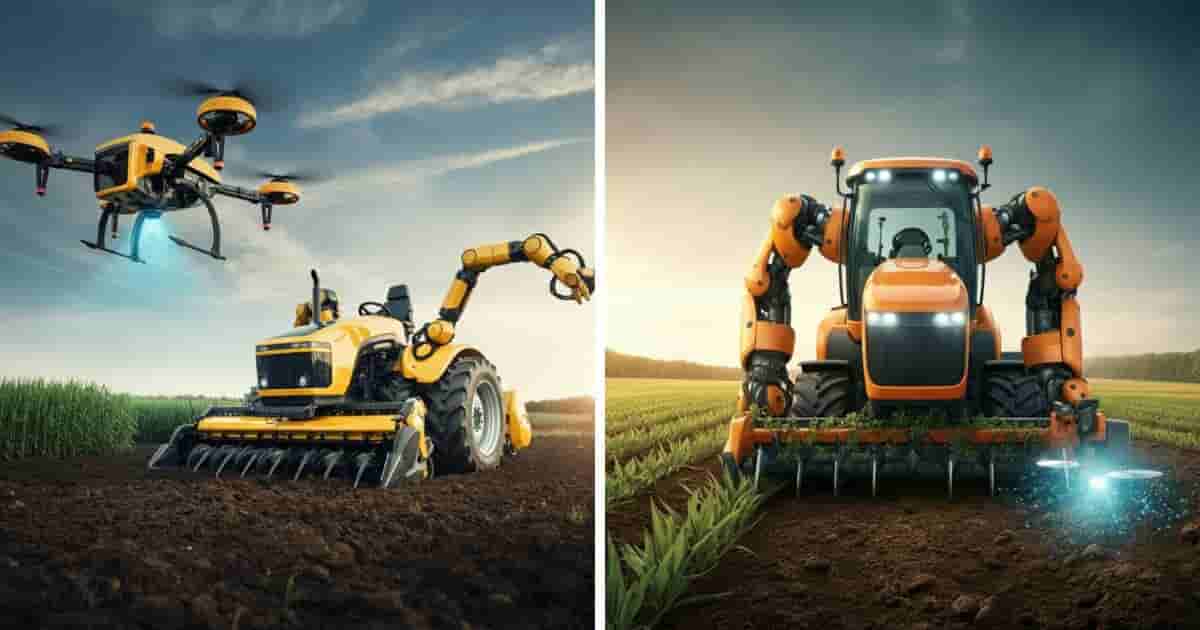
- Manufacturing
Third sector entitled to the future of robotics is their use in manufacturing.
- Industrial Robots: Automate tasks like welding, assembling, and packaging.
- Collaborative Robots (Cobots): Work alongside humans to enhance productivity and safety.
- Quality Control: Robots use sensors and cameras for defect detection.
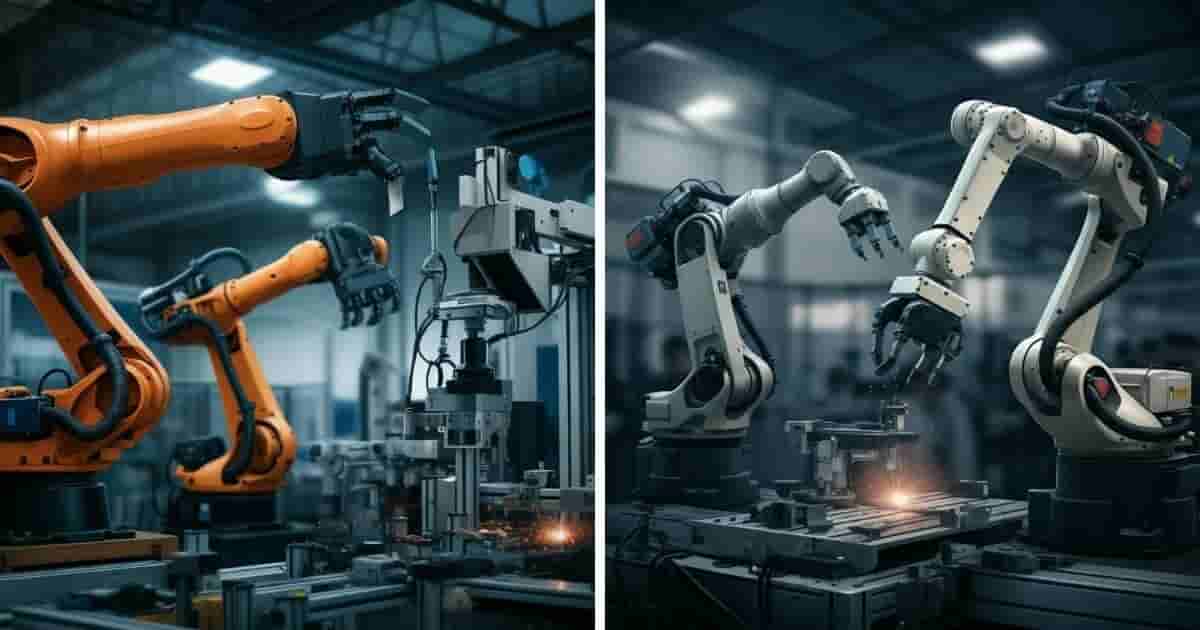
- Warehousing and Logistics
Fourth sector entitled to the future of robotics is their use in warehousing and logistics.
Automated Systems: Robots manage inventory, move packages, and optimize storage.
- AMRs and AGVs: Transport goods across large warehouses autonomously.
- Last-Mile Delivery: Robots and drones speed up delivery from warehouses to customers.
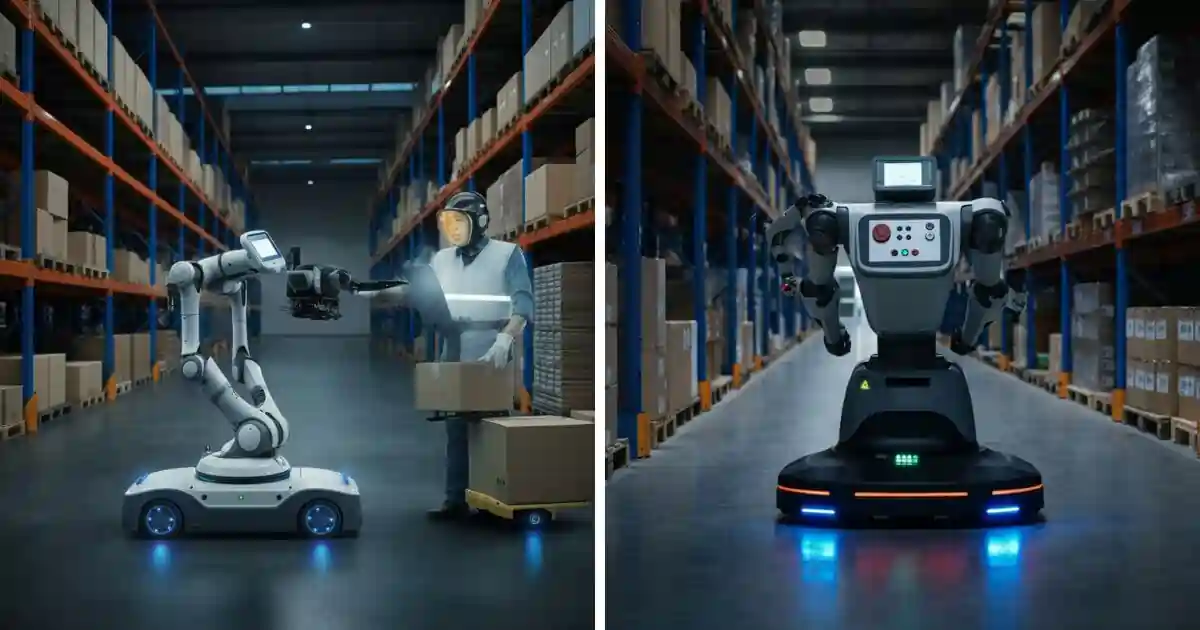
- Space Exploration
Another exciting sector entitled to the future of robotics is their use in space exploration.
- Mars Rovers: Collect data and explore the Martian surface autonomously.
- Robotic Arms: Assist astronauts in space with tasks like satellite assembly and equipment repair.
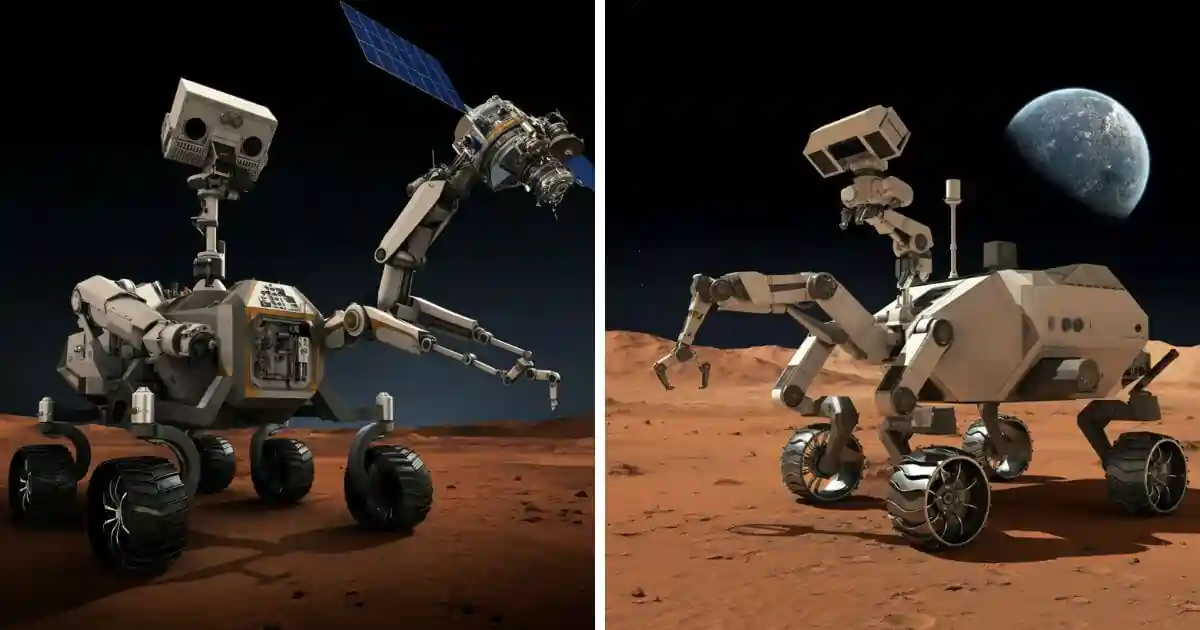
- Defense and Military
The sixth sector entitled to the future of robotics is their use in defense and military.
- Drones: Perform surveillance, reconnaissance, and targeted strikes.
- Bomb Disposal Robots: Neutralize explosive devices remotely.
- Autonomous Vehicles: Navigate hazardous environments for reconnaissance or supply missions.
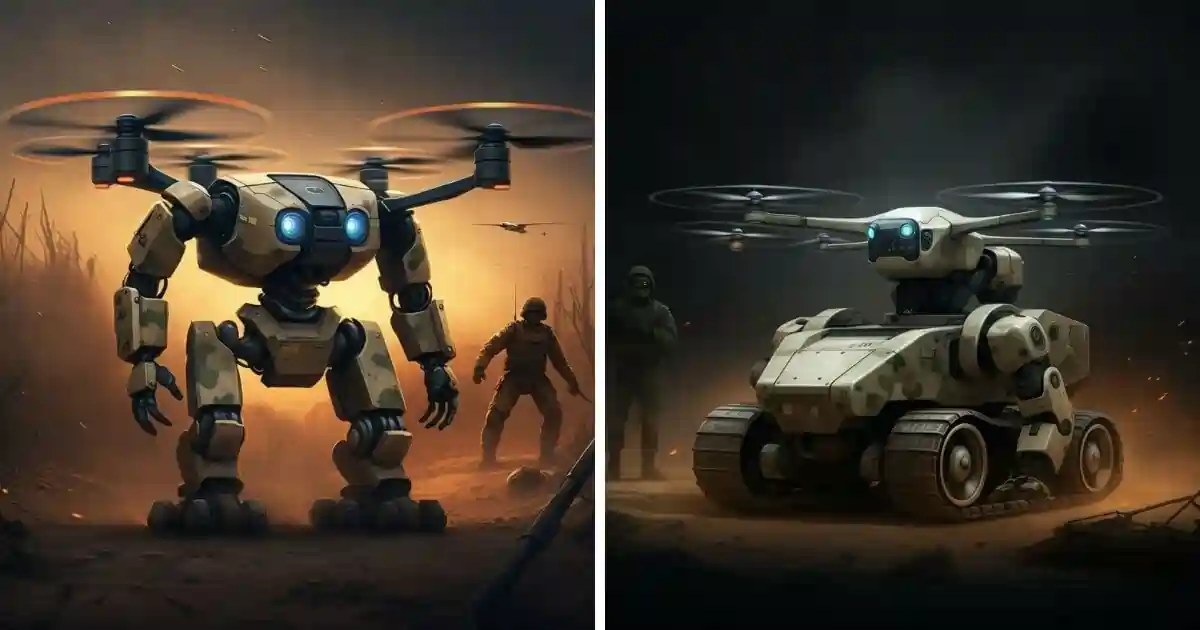
- Retail
The seventh sector entitled to the future of robotics is their use in retail.
- Inventory Management: Robots track stock levels and restock shelves.
- Customer Service: Robots assist customers with finding products or offering information.
- Robotic Delivery: Speed up the delivery process in urban areas.
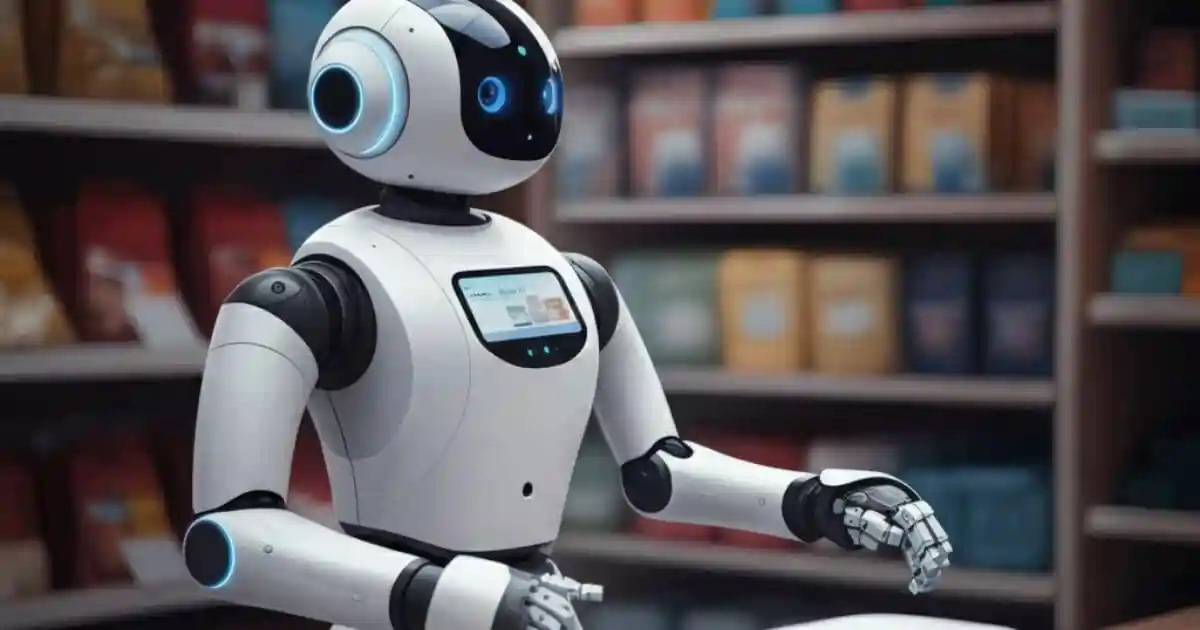
- Entertainment
Another sector entitled to the future of robotics is their use in entertainment.
- Theme Parks: Animatronic robots bring characters to life.
- Interactive Exhibits: Robots engage visitors in museums, concerts, and art installations.
- Personalized Companions: Robots for companionship, education, and entertainment.
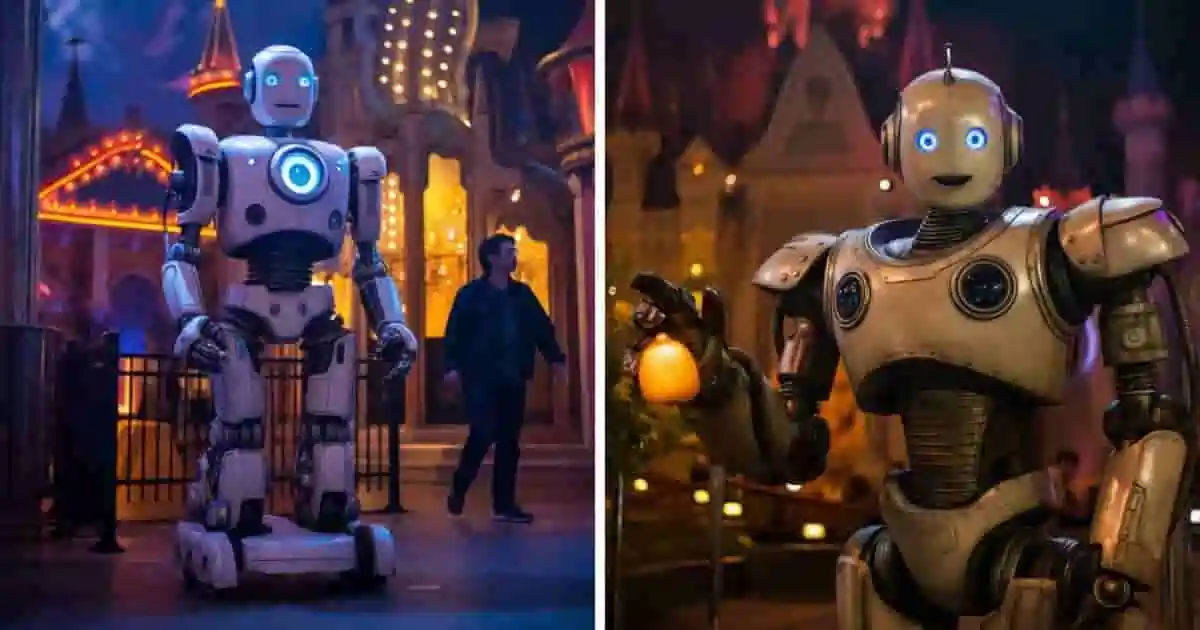
- Hospitality
The ninth sector entitled to the future of robotics is their use in hospitality.
- Robot Concierges: Check-in guests and provide concierge services.
- Food Delivery Robots: Serve food and beverages in restaurants or hotels.
- Cleaning Robots: Automate cleaning tasks in hotels and public spaces.
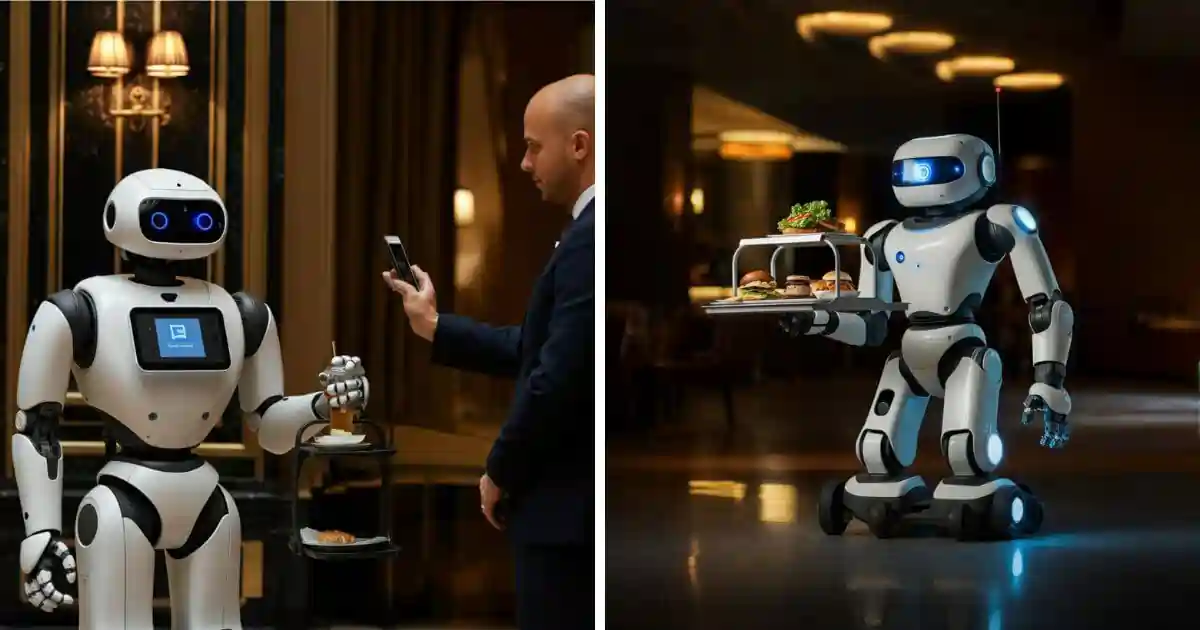
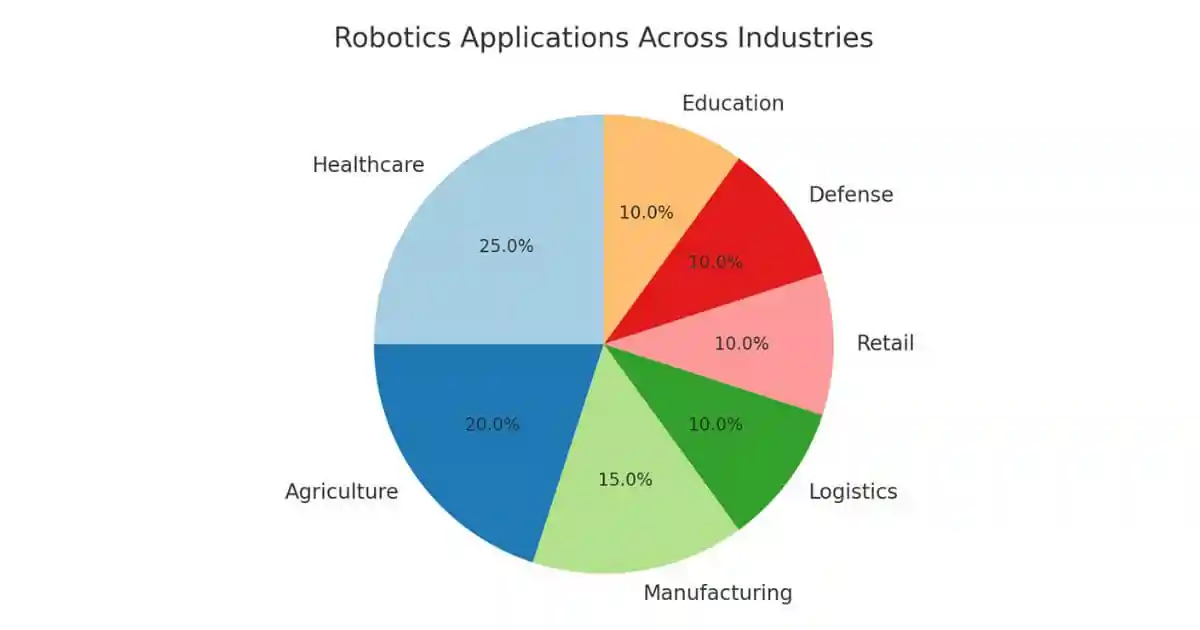
Types and Categories of Robots
Future of robotics is promising as robots come in many forms, each designed for specific industries and tasks. Here are some different kinds of robots:
- What is Humanoid Robot?
- Design: These robots resemble the human body in structure, with a head, arms, legs, and a torso.
- Purpose: Designed to replicate human actions, they can interact with people and perform tasks that require human-like dexterity.
- Examples:
- Sophia: A robot with facial recognition and advanced communication abilities.
- Honda’s ASIMO: A robot designed to help with tasks like walking, running, and even dancing.
- Applications: Healthcare assistance, personal companionship, and customer service.
- Industrial Robots
- Design: Typically, robotic arms or robotic systems built to perform repetitive tasks with high precision.
- Purpose: Primarily used in industrial and manufacturing settings, they increase productivity and ensure consistent quality in addition to industry automation.
- Examples:
- KUKA Robots: Used in automotive production lines for welding, painting, and assembly.
- Fanuc Robots: Known for their precision in tasks such as material handling, packaging, and assembly.
- Applications: Automotive assembly, electronics manufacturing, packaging, and heavy-duty industrial tasks.
- Service Robots
- Design: These robots are designed to perform tasks for humans, often in domestic or service environments.
- Purpose: They are focused on improving quality of life by handling everyday tasks, both in private and commercial spaces.
- Examples:
- Roomba: A robotic vacuum cleaner that autonomously cleans floors.
- Pepper Robot: A social robot capable of reading emotions and engaging with customers.
- Applications: Cleaning, delivery services, customer service, and personal assistance.
- Autonomous Robots
- Design: Equipped with sensors, cameras, and advanced algorithms, these robots can navigate and make decisions on their own.
- Purpose: Designed to perform tasks without human intervention, they are ideal for environments where human presence is unsafe or inefficient.
- Examples:
- Self-Driving Cars: Autonomous vehicles like Tesla and Waymo use AI to navigate traffic safely.
- Drones: Unmanned aerial vehicles used for tasks like surveillance, delivery, and mapping.
- Applications: Transport, logistics, surveillance, search and rescue, and the robotics in agriculture.
- Collaborative Robots (Cobots)
- Design: These robots are engineered to work safely and effectively alongside humans without the need for safety barriers.
- Purpose: Cobots are designed to assist humans with tasks that require precision, strength, or repetition, enhancing productivity without replacing human workers.
- Examples:
- Universal Robots: Known for their flexibility and ease of use in manufacturing and assembly lines.
- Rethink Robotics’ Baxter: A versatile robot used for tasks like material handling and product assembly.
- Applications: Automation manufacturing industry i.e. small-scale manufacturing, assembly lines, and logistics.
- What is Mobile Robot?
- Design: These robots are capable of moving through different environments using wheels, tracks, or legs.
- Purpose: Mobile robots are used in situations where mobility is required to transport goods, perform inspections, or provide services across various environments.
- Examples:
- AMRs (Autonomous Mobile Robots): Robots used for material handling in warehouses and factories.
- Boston Dynamics’ Spot: A quadruped robot that can navigate rugged terrains.
- Applications: Warehousing (Automated warehouse robots), exploration (e.g., Mars rovers), and military operations.
- Military Robots
- Design: Military robots are built to perform tasks that are too dangerous for humans in hostile environments, often equipped with sensors and weaponry.
- Purpose: These robots are designed for surveillance, reconnaissance, bomb disposal, and tactical support.
- Examples:
- PackBot: A robot used for bomb disposal and reconnaissance in dangerous areas.
- TALON Robots: Military robots designed for urban combat and reconnaissance.
- Applications: Military defense, bomb disposal, surveillance, and search and rescue.
- Exploration Robots
- Design: Robots designed for extreme conditions, like space, deep-sea exploration, or hazardous areas on Earth.
- Purpose: Used to explore environments that are too dangerous, remote, or difficult for humans to access.
- Examples:
- Mars Rovers (e.g., Curiosity, Perseverance): Robots designed to explore the Martian surface, collecting data for scientific research.
- Deep-Sea Robots: Used for underwater exploration, like the OceanGate submersibles.
- Applications: Space exploration, deep-sea research, and hazardous environment surveying.
- Educational Robots
- Design: These robots are designed to help teach children and adults about robotics, coding, and technology.
- Purpose: Used in educational settings to provide hands-on learning experiences and foster interest in STEM fields.
- Examples:
- LEGO Mindstorms: A programmable robot kit used in schools to teach robotics and engineering principles.
- Edison Robot: An affordable robot designed to teach coding and robotics concepts.
- Applications: Classroom education, coding workshops, and STEM outreach programs.
Visual Aid: Add a carousel slider showcasing images of these robot types with a brief description of each.
Emerging Trends in Robotics for 2025
As we look toward future of robotics particularly in 2025, several exciting trends are emerging that will further enhance the capabilities of robotics:
- AI Integration in Robotics
- Trend Overview: Artificial intelligence is transforming the capabilities of robots, making them more adaptive and intelligent. AI enables robots to learn from their environments, process complex data, and make decisions autonomously.
- Key Developments:
- Emotional Intelligence: Robots will increasingly be able to understand and respond to human emotions, enhancing their interactions in healthcare, customer service, and caregiving.
- Autonomous Decision-Making: AI will allow robots to perform tasks with minimal human intervention, especially in unpredictable or dynamic environments.
- Applications: Healthcare (e.g., surgical robots), customer service (e.g., humanoid robots), autonomous vehicles, and industrial automation.
- Agricultural Robotics
- Trend Overview: As the global population grows, agriculture will need to evolve to meet food demands. Robotics is playing a significant role in improving crop yields, optimizing resource use, and reducing labor costs.
- Key Developments:
- Precision Farming: Robots will help monitor soil conditions, detect pests, and even harvest crops autonomously. This will reduce waste and increase the efficiency of agricultural processes.
- Drones for Agriculture: Drones will become more prevalent in crop monitoring, pesticide spraying, and seed planting, enhancing the precision and speed of agricultural operations.
- Applications: Precision farming, automated harvesting, pest management, and crop monitoring.
- Warehouse and Logistics Automation
- Trend Overview: Future of robotics is enabling automation in warehouses and logistics. It will continue to grow, driven by the demand for faster deliveries and more efficient inventory management.
- Key Developments:
- Robotic Picking Systems: Robots will be capable of handling more complex picking and packing tasks, working alongside human workers to optimize speed and reduce errors.
- Autonomous Delivery Robots: Delivery robots and drones will be used to transport goods within warehouses and directly to customers, improving delivery times and reducing operational costs.
- Applications: E-commerce fulfillment, inventory management, last-mile delivery, and sorting.
- Humanoid Robots
- Trend Overview: Future of robotics will help evolve humanoid robots for more complex and personalized tasks, especially in environments where human-like interaction is essential.
- Key Developments:
- Personal Assistance: Robots like Elon Musk’s Optimus project aim to assist with everyday tasks such as household chores, caregiving, and elderly assistance, making them more integrated into daily life.
- Healthcare Assistance: Humanoid robots will play a key role in providing physical and emotional support to the elderly and people with disabilities, improving their quality of life.
- Applications: Elderly care, home assistance, customer service, and healthcare support.
- Collaborative Robots (Cobots)
- Trend Overview: Cobots, robots designed to work safely alongside humans, are becoming more common in various industries. These robots are designed to augment human capabilities rather than replace them.
- Key Developments:
- Increased Flexibility: Cobots will become more adaptable to various tasks, including complex assembly processes, and will be able to operate in dynamic environments.
- Ease of Use: With intuitive interfaces and user-friendly designs, cobots will allow workers with minimal technical expertise to program and control them.
- Applications: Manufacturing, small-scale production, assembly lines, and healthcare (assisting medical staff).
- Soft Robotics
- Trend Overview: Soft robotics is an emerging field that focuses on creating robots from flexible materials that can interact with delicate or irregular objects. These robots are ideal for tasks that require sensitivity or adaptability.
- Key Developments:
- Flexible Materials: Soft robots are made from materials like silicone, which allows them to bend, stretch, and change shape to complete tasks that rigid robots cannot.
- Gentle Handling: Soft robots will be used for tasks like handling fragile objects (e.g., fruits and flowers) and delicate surgeries where precision and safety are paramount.
- Applications: Food handling, medical surgeries, rehabilitation, and handling delicate materials.
- Future of Robotics in Space Exploration
- Trend Overview: Future of robotics will continue to be at the forefront of space exploration, enabling humanity to reach new planets and moons, while performing tasks that are too dangerous or time-consuming for humans.
- Key Developments:
- Exploration on Mars: Robots like NASA’s Perseverance rover and NASA’s Ingenuity drone are already helping scientists learn more about Mars. In 2025, we may see more advanced robots that can autonomously explore and analyze new areas.
- Mining and Resource Collection: Robots will also be used to mine resources from asteroids or the Moon, providing essential materials for space missions and future colonization efforts.
- Applications: Mars exploration, lunar resource collection, satellite maintenance, and asteroid mining.
- Ethical and Social Implications
- Trend Overview: As the future of robotics advances, ethical and social implications will become more significant. There will be a growing need to address concerns like privacy, job displacement, and decision-making in critical situations.
- Key Developments:
- AI Ethics: As robots gain more decision-making power, issues like bias, accountability, and fairness will become key concerns. Ethical frameworks will need to be established to guide AI behavior.
- Job Displacement: Automation will continue to replace certain jobs, raising questions about the future of work and how displaced workers will be retrained or supported.
- Applications: Ethical AI development, workforce retraining programs, and regulation of autonomous systems.
- Quantum Robotics
Trend Overview: Quantum computing could provide robots with the massive computing power needed for real-time, high-level decision-making in complex and unpredictable environments.
- Key Developments:
- Faster Decision-Making: Quantum robotics will enable robots to process large datasets at unprecedented speeds, opening up new possibilities in industries like healthcare, logistics, and autonomous vehicles.
- Improved AI Capabilities: Quantum algorithms may improve the AI that drives robots, leading to more intelligent, adaptive, and reliable systems.
- Applications: Future of robotics is used in healthcare diagnostics, real-time decision-making in autonomous systems, and AI-driven industrial automation.
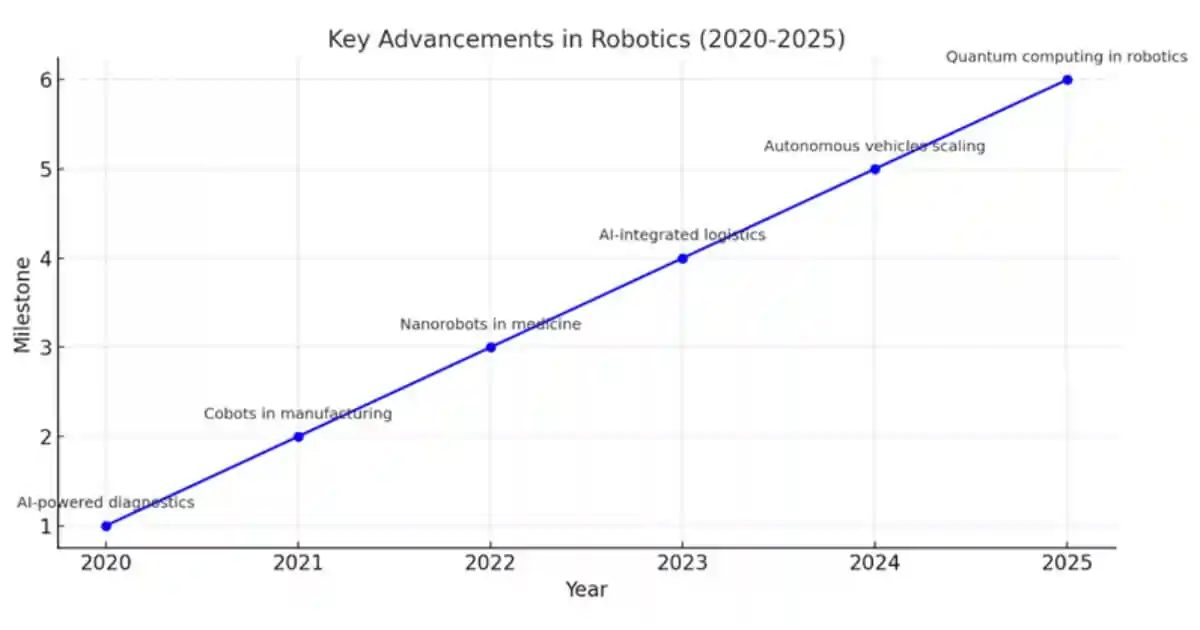
Why Pursue a Career in Robotics?
As we approach 2025, the professional landscape is shifting rapidly. While technical expertise remains essential, soft skills for 2025 are on an emerging trend. Similarly, the future of robotics industry is booming, offering diverse job opportunities in robotics, with competitive salaries. Here’s what you need to know:
Growing Fields in Robotics
The future of robotics will play an increasingly critical role in industries like healthcare, manufacturing, and agriculture. The following fields are expected to experience significant growth in automation and robotics:
Robotic Process Automation (RPA)
- Overview: Robotic Process Automation (RPA) involves using software robots or “bots” to automate repetitive tasks in business processes. RPA is particularly popular in industries like finance, insurance, and customer service.
- Why It’s Growing: RPA reduces costs, increases accuracy, and improves efficiency in business operations. As more companies seek automation solutions, the demand for professionals in RPA will continue to rise.
- Key Roles:
- RPA Developer
- RPA Analyst
- RPA Consultant
Nanorobotics
- Overview: Nanorobotics is the field of designing robots at a very small scale, often at the molecular level. These robots can be used in medicine, materials science, and manufacturing.
- Why It’s Growing: Nanorobots hold immense potential in medical applications, including targeted drug delivery, cancer treatment, and minimally invasive surgeries.
- Key Roles:
- Nanorobotics Researcher
- Nanotechnology Engineer
- Biomedical Engineer (specializing in nanorobotics)
AI and Robotics Engineering
- Overview: AI and robotics engineering involves the integration of machine learning and artificial intelligence with robotics systems. This field focuses on making robots smarter, allowing them to perform tasks autonomously and intelligently.
- Why It’s Growing: As robots become more autonomous, AI and machine learning will play a crucial role in enhancing their capabilities, from self-learning algorithms to complex decision-making processes.
- Key Roles:
- AI Engineer
- Machine Learning Specialist
- Robotics Software Engineer
High-Demand Job Roles in Robotics
The increasing demand for skilled professionals is a reality in the future of robotics. The following job roles are expected to be among the most sought after in the robotics sector by 2025:
Robotics Engineer
- Role Overview: Robotics engineers design, build, and test robotic systems, working in a variety of industries, from manufacturing to healthcare. They integrate mechanical, electrical, and computer engineering to create functional robots.
- Skills Needed: Strong knowledge of mechanical and electrical engineering, programming languages (C++, Python), and experience with robotic simulation software.
- Average Salary: $85,000 – $130,000 (USD)
Automation Specialist
- Role Overview: Automation specialists are responsible for creating and maintaining automated systems, such as robotic production lines or warehouse automation. They focus on optimizing workflows and improving efficiency through automation technologies.
- Skills Needed: Expertise in automation software, robotics, industrial engineering, and systems integration.
- Average Salary: $75,000 – $120,000 (USD)
Robotics Researcher
- Role Overview: Robotics researchers push the boundaries of what robots can do, conducting experiments to advance robotic technology. They often work in academic, governmental, or corporate research settings.
- Skills Needed: Advanced understanding of robotics, programming, data analysis, and problem-solving.
- Average Salary: $90,000 – $140,000 (USD)
Robotics Technician
- Role Overview: Robotics technicians are responsible for assembling, installing, and maintaining robotic systems. They are hands-on professionals who ensure that robots operate smoothly and efficiently.
- Skills Needed: Technical expertise in electrical and mechanical systems, troubleshooting, and familiarity with robotics programming.
- Average Salary: $50,000 – $70,000 (USD)
AI and Machine Learning Specialist
- Role Overview: AI and machine learning specialists are integral in developing intelligent algorithms that enable robots to perform complex tasks. They work on improving the decision-making and learning capabilities of robots through deep learning, neural networks, and reinforcement learning.
- Skills Needed: In-depth knowledge of machine learning algorithms, AI frameworks (e.g., TensorFlow), and programming languages such as Python and R.
- Average Salary: $100,000 – $150,000 (USD)
Emerging Robotics Specializations
By 2025, new technologies will further innovate the future of robotics and give rise to emerging specializations that focus on niche areas of the industry. Here are a few to watch:
Humanoid Robotics
- Overview: Humanoid robots, which mimic human behaviors and movements, will be crucial in fields like personal assistance, caregiving, and customer service.
- Job Roles: Humanoid Robot Designer, Human-Robot Interaction Specialist, Robotic Caregiver.
Autonomous Vehicle Engineering
- Overview: As self-driving vehicles become more widespread, engineers specializing in autonomous vehicle systems will be in high demand.
- Job Roles: Autonomous Vehicle Engineer, Sensor Specialist, Robotics Vehicle Designer.
Medical Robotics
- Overview: Medical robots, particularly those used in surgery, diagnostics, and rehabilitation, are becoming more advanced, requiring specialized knowledge in both robotics and healthcare.
- Job Roles: Medical Robotics Engineer, Robotic Surgery Specialist, Rehabilitation Robotics Expert.
Skills Needed for Robotics Careers in 2025
As the future of robotics becoming more interdisciplinary, professionals will need to have a combination of skills, including:
- Programming Skills: Proficiency in programming languages like Python, C++, and Java is essential for developing robotic systems.
- Mechanical and Electrical Engineering: A strong foundation in engineering principles is necessary to design and build functional robots.
- Problem-Solving and Creativity: Robotics requires innovative thinking to solve complex technical challenges.
- Knowledge of AI and Machine Learning: AI integration will be critical in the evolution of robotics, making knowledge of these fields an essential skill for future professionals.
- Communication Skills: Many robotics roles require collaboration between engineers, designers, and stakeholders, making effective communication crucial.
Future of Robotics in Emerging Markets
As future of robotics has become a reality, emerging markets are increasingly adopting robotics technologies. Countries like India, China, and Brazil are investing heavily in automation and robotics, opening up new opportunities for professionals in these regions. Robotics engineers, technicians, and AI specialists will be in high demand to support these growing industries.
High-Demand Roles:
- Robotics Engineer: Design and develop robotic systems. Average salary: $95,000/year.
- AI Specialist: Create algorithms for robot cognition.
- Nanotechnology Engineer: Develop nanorobots for medical and industrial use.
- Automation Consultant: Implement robotic solutions in businesses.
Salary Insights
| Field | Average Salary (USD) |
| Robotics Engineer | $85,000 – $130,000 |
| Nanorobotics Specialist | $100,000 – $160,000 |
| Automation Specialist | $75,000 – $120,000 |
Top Sectors Hiring Robotics Professionals
| Field | Job Roles | Growth Potential |
| Healthcare | Medical Robotics Engineer | High |
| Manufacturing | Automation Specialist | Moderate |
| Agriculture | Agritech Engineer | High |
| Space Exploration | Robotics Programmer | High |
Future of Robotics: Ethical and Social Impact
While the rise and future of robotics promises numerous benefits, it also raises several ethical and social concerns:
- Job Displacement: The automation of traditional roles could lead to unemployment in sectors like manufacturing and retail.
- Ethical Dilemmas: As AI continues to drive decision-making, questions about accountability and fairness in life-and-death scenarios will become more critical.
- Overdependence on Robots: Excessive reliance on robots in industries and households could pose risks, especially if systems fail unexpectedly.
The Future of Robotics Beyond 2025
The future of robotics looks incredibly promising, with new technologies and innovations on the horizon:
- Hybrid Robots
- Features: Combining soft and rigid components, these robots will adapt to various tasks, from heavy lifting to precise operations.
- Impact: Transform industries like healthcare, manufacturing, and rescue missions with more versatile robots.
- Deep Robotics
- Applications: Robots for deep-sea exploration and space missions will be designed to withstand extreme conditions.
- Potential: These robots could revolutionize scientific research and assist with Mars missions and oceanographic studies.
- Humanoid Companions
- Features: Robots capable of understanding and responding to human emotions, improving caregiving and personal assistance.
- Impact: Could reshape elderly care, mental health support, and social interaction.
- Autonomous Robots in Daily Life
- Applications: Self-driving cars, autonomous delivery robots, and robots for household tasks will become mainstream.
- Impact: Improve safety, efficiency, and convenience, from transportation to everyday chores.
- AI Integration: Smarter Robots
- Features: Robots will use machine learning to continuously improve, adapt to new situations, and work more autonomously.
- Impact: Enhance human-robot collaboration in diverse fields, from healthcare to manufacturing.
- Smart Materials and Self-Healing Robots
- Features: Robots using self-repairing materials will reduce maintenance costs and operate in hazardous environments.
- Impact: Self-healing robots will be crucial in space exploration, deep-sea missions, and disaster recovery.
- Ethics and Regulation
- Challenges: As robots become more autonomous, ethical concerns about AI decision-making, robot rights, and privacy will need to be addressed.
- Impact: Governments and industries will develop regulations for robot integration and AI ethics.
- Robotics in Healthcare
- Applications: Surgical robots, caregiving robots, and AI-driven diagnostics will revolutionize healthcare.
- Impact: Improve patient outcomes, reduce surgical risks, and provide support for elderly or disabled individuals.
- New Careers in Robotics
- Opportunities: Robotics will create new jobs in AI training, robot maintenance, and ethics.
- Impact: Reskilling programs will prepare the workforce for this new era of automation.
Global Leaders in Robotics:
- USA: Leading in AI-driven robotics and automation.
- Japan: Known for pioneering humanoid robots like ASIMO.
- Germany: A leader in industrial robotics, focusing on precision engineering
Challenges to Overcome:
The challenges to overcome which are going hand in hand with the progress and future of robotics are:
- Ensuring safety and reliability in autonomous systems.
- Addressing ethical concerns about AI and job displacement.
Conclusion: Embracing Future of Robotics
The future of robotics is here, driving innovation across industries and reshaping the world as we know it. As we look toward 2025, it’s clear that robotics will continue to integrate with AI, transforming fields like agriculture, healthcare, and manufacturing. Whether you’re a professional exploring job opportunities in robotics or a tech enthusiast keen on understanding the future of robotics, now is the time to embrace this fascinating field.
Let us know your thoughts: What do you think is the most exciting trend and future of robotics in 2025?
Do you want to stay ahead in the world of robotics? Subscribe to our newsletter and get the latest updates on career opportunities, trends and future of robotics!
FAQs
- What is the future of robotics in 2025? Future of robotics will see smarter AI, nanorobots in medicine, and expanded use in agriculture and manufacturing.
- What are the 4 types of robotics? The main types include industrial, medical, service, and military robots.
- Is robotics a promising career? Yes, it offers high growth potential, competitive salaries, and diverse opportunities across industries.
- What is the biggest challenge in robotics? Ensuring safety in autonomous systems and addressing ethical concerns are directly linked to the future of robotics industry.
- Which countries lead in robotics innovation? Countries like Japan, the USA, and Germany are pioneers in robotics development.
- How does AI impact robotics? AI enhances robot adaptability, enabling smarter decision-making and autonomous operations, thus paving the way for bright future of robotics.
- What is nanorobotics? It involves creating microscopic robots for tasks like targeted drug delivery and precision surgery.
- Who are the Big Four of robotics? The Big Four of robotics are: Boston Dynamics, ABB Robotics, KUKA Robotics, and Fanuc Corporation.


























